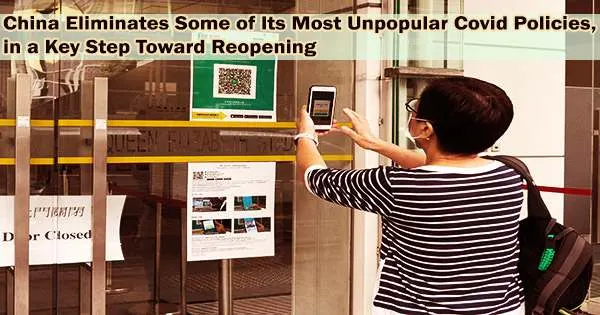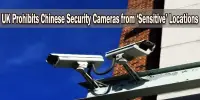On Wednesday (December 7, 2022), China made substantial modifications to its national pandemic response. This is the clearest and most important indication yet that the central government is reversing its stringent zero-Covid policy, which sparked nationwide demonstrations.
China’s State Council published 10 new guidelines that relax some regulations, most notably allowing home quarantine and essentially doing away with the health QR code that had been required for entry into most public areas, according to a statement carried by state broadcaster CCTV.
This week, local governments already took actions that suggested a potential shift of course, including some big cities relaxing their requirements for Covid testing.
The fact that Beijing has reversed course after maintaining for the previous three years that stringent limitations are the only practical means of eradicating the highly contagious virus is remarkable. This is the first time that the country’s Covid policy has been officially altered.
Here are some of the biggest changes.
QR codes scrapped
China has been tracking people’s health statuses using health codes on mobile phones from the beginning of the outbreak. Depending on whether these codes are red, amber, or green, users are either permitted to leave their houses, travel by public transportation, and visit public areas, or they may need to be quarantined.
After nearly three years of upheaval to people’s daily routines and means of subsistence, the guidelines unveiled on Wednesday will allow people to enter most locations without presenting a negative test result or their health code.
Only a small number of places, such as nursing homes, hospitals, and secondary schools, will continue to demand these checks. The research also said that businesses can now choose their own prevention and control strategies.
Home quarantine allowed
Another significant difference is that, unless they specifically request otherwise, asymptomatic or mildly symptomatic Covid patients will be permitted to quarantine at home rather than being transported to a government facility.
Patients whose condition deteriorates will be transferred to hospital for treatment, the report said. Close contacts can also quarantine at home.
Chinese citizens have complained about the turmoil and stress of entering quarantine camps during the pandemic, with many stating it was unclear when they would be permitted to leave and others lamenting the crowded or subpar circumstances.
Health professionals apparently killed pets belonging to people placed in government quarantine in a number of instances, alleging health hazards each time, inciting uproar on Chinese social media. After hearing earlier this year that elderly residents were being dragged from their houses in the middle of the night to be taken to quarantine, some people opposed the approach.
Limits on lockdown
The new guidelines also urge authorities to “ensure the normal functioning of society and basic medical services,” saying areas that aren’t designated high-risk should not restrict people’s movements or close businesses.
Lockdowns are only allowed in “high-risk areas,” and even then, should be “promptly” lifted if no new cases are found for five consecutive days, it said. In order to ensure that inhabitants may still leave and get medical assistance if necessary, it was added that authorities were not allowed to block fire escapes, apartment or building entrances, or other gates.
This particular guideline comes at a particularly sensitive time, with China still reeling from a wave of rare public protest in late November and early December, that had been triggered by a deadly fire in the far western Xinjiang region. Public fury had swept the nation after videos of the incident appeared to show lockdown measures had delayed firefighters from reaching the victims.
During the protests, thousands across the country took to the streets to call for an end to lockdowns and other zero-Covid measures with some voicing broader grievances against censorship and the ruling Communist Party’s authoritarian leadership.
Vaccination plan
The State Council on Wednesday also emphasized the need to accelerate Covid vaccination among the elderly, saying all locations should be “administrating as many vaccinations as possible.”
Even though the Omicron variant is milder than previous strains and China’s overall vaccination rate is high, experts warn that if infections spread rapidly throughout the 1.4 billion-person nation, even a small number of severe cases among vulnerable and under-vaccinated groups like the elderly could overwhelm hospitals.
More than 86% of China’s population over 60 are fully vaccinated, according to China’s National Health Commission. That leaves around 25 million who have not received any shot, according to a comparison of official population figures and November 28 vaccination data. But booster rates are lower, with more than 45 million of the fully vaccinated elderly yet to receive an additional shot.
For the most at-risk over 80 age group, around two-thirds were fully vaccinated, but only 40% had received booster shots as of November 11, according to state media.
Domestic travel
The rules also make domestic travel within China easier, with cross-regional travelers no longer needing to provide a negative test result or their health code or test upon arrival.
These former requirements, as well as other travel restrictions such as provincial border closures and provincial train and bus suspensions, have made domestic travel difficult over the last few years.
For the many Chinese people who moved away from their hometowns in search of employment in other cities and provinces, this meant experiencing extended periods of family separation or being stuck far from home without a source of income during sudden lockdowns.
Recent days have seen several social media users draw attention to the fact that Lunar New Year, the nation’s biggest annual holiday, is just one month away. Similar to American Thanksgiving, this is a time when individuals traditionally travel home to spend time with their families.
For some, the prospect of mass nationwide travel has raised concern of the virus spreading once more. Others, long fatigued with the toll of zero-Covid, greeted the news with relief.
“I haven’t been home for Chinese New Year for two years now, I’m crying,” one person said on Weibo. Another wrote: “It’s been a long time. Welcome home.”
Medicine, schools, and monitoring
A few other guidelines are also likely to ease the transition away from zero-Covid toward a less disruptive model.
For instance, schools without Covid outbreaks are now asked to carry out “normal offline teaching activities,” and to reopen on-campus facilities such as cafeterias, libraries and sports venues. Schools with Covid cases can continue “normal teaching and living,” as long as they designate certain “risk areas” with control measures.
The recommendations also stress the need to remove barriers that previously made it challenging to purchase cold and fever medications in pharmacies. China has required a prescription and a negative Covid test to purchase them from the beginning of the pandemic.
Perhaps reflecting public concern that the relaxation in rules could cause a surge in cases, residents have rushed to drug stores, with reports last week that cold and fever medicines were flying off shelves.
The State Council also urged doctors and local medical institutions to continue closely monitoring the health situation of key populations, including the risks posed to elderly or immunocompromised residents.
A wider reopening will unavoidably pose health hazards, especially to people in vulnerable categories, according to several experts.
“The key risk when countries decide to move away from a zero-Covid policy is really the strain this will exert on the health care system,” said Ruklanthi de Alwis, deputy director for the Centre for Outbreak Preparedness at the Duke-NUS Medical School in Singapore.
















